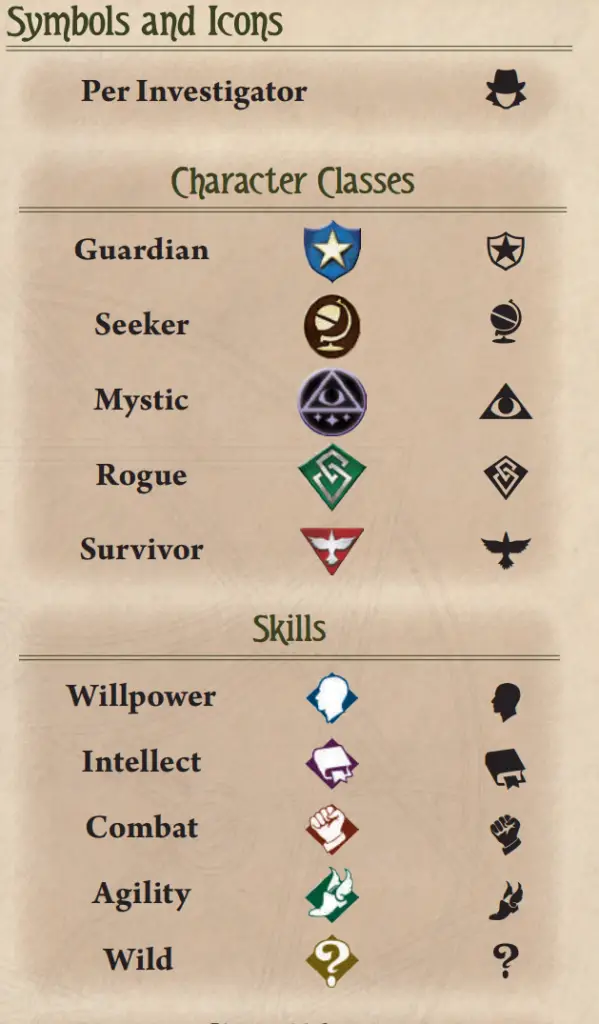Arkham Horror Card Game Setup
In this section of How to Play Arkham Horror Card Game Rules, we list out the steps to set up the game.
To get the step by step Arkham Horror Card Gameplay Rules Guide, click here.
Step-by-step guide on Arkham Horror Card Game Setup.
Player Setup – Choose Your Investigator
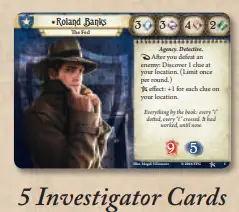
Choose an investigator card and place in your play area. Select one player to be Lead Investigator and give the player the Campaign Guide. Lead Investigator break ties and makes the decision for the group when there is a conflict.
Player Setup – Build and Shuffle Player Decks
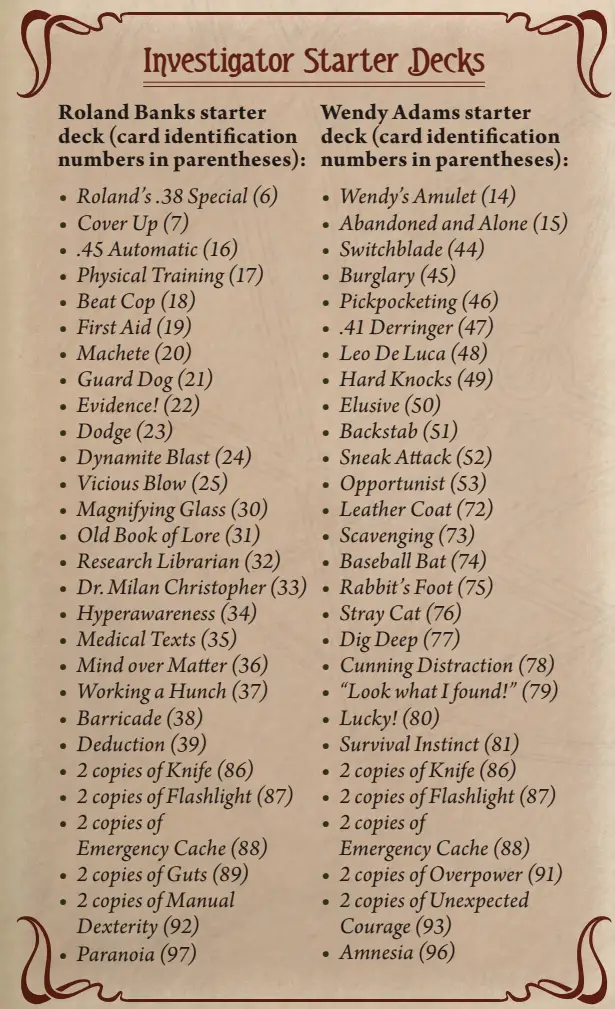
The cards used in each of the recommended investigators’ starter decks are detailed in the “Investigator Starter Decks” sidebar.
Player Setup – Assemble token pool and chaos bag
Assemble token pool
Place damage, horror, clue/doom, and resource tokens within easy reach
Assemble chaos bag Place 16 chaos tokens into opaque container/bag (during the game, players will be asked to randomly reveal tokens form bag)
Player Setup – Starting resources and opening hands
Take starting resources – each player takes 5 resources from the token pool (resources are spent to play cards during the game)
Draw opening hands – Each player draws 5 cards from their deck.
If weakness card is drawn, set aside instead of adding to hand, draw an additional card and shuffle weakness card back into the deck
Each player re-draw the cards once by setting the 5 drawn cards aside, re-drawing another 5 and re-shuffling the set-aside cards back into the deck
1. Read scenario introduction ‘The Gathering’
Scenario setup – Encounter Cards
Introduction narrates the story, players listen as details may inform them how to decide their moves.Find the encounter card sets that will be used for the scenario:
The Gathering card set
Striking Fear card set
Ancient Evil card set
Chilling Cold card set
Scenario setup – Set Agenda Deck
Assemble agenda deck in sequential order, using agenda cards from the above card sets. Agenda cards represent the progress of Mythos (the enemy). Players will try to limit the advancement of this deck.
Scenario setup – Set Act Deck
Assemble Act cards in sequential order. Read story text on Act 1a.
Act deck represents the team’s progress towards solving the mystery
Scenario setup – Scenario Card
Place scenario reference card for “The Gathering” (card 104a) next to agenda deck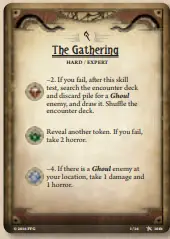
Card is referenced each time a Chaos token is taken from the chaos bag/container. It will determine how the token affects the game.
Scenario setup – Put Study into Play
When a location is in play, the card always enters play with its UNREVEALED side face up.
The keyhole symbol under the title represents the UNREVEALED side.
Set every other location cards aside, out of play (cards 112-115). The Hallway, Attic, Cellar and Parlor cards are set aside for now.
Scenario Setup – Players begin in the Study
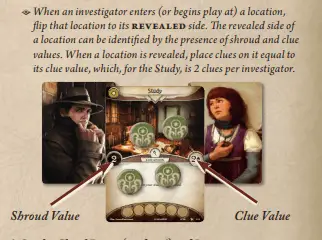
Each player begins play in the Study. Players place their mini card next to the Study to represent being in there. When a player enters a location, the card flips to REVEALED side. When revealed, place clues on it equal to its clue value. The study has 2 clues per investigator as shown below.
Scenario Setup – Assemble Encounter Deck
Set the Ghoul Priest (card 116) and Lita Chantler (card 117) aside
Assemble the encounter deck.
Shuffle remaining encounter set cards (see step 2) and create the encounter deck. The cards will be drawn during the game and will represent dangers, monsters that the players
Key Game Concepts
The Golden Rule
Here are some concepts to know when playing the game.
The Golden Rule
- If the text on card contradicts the rule book, observe the instructions on the card
“In Player Order”
- “In player order” determines the order which players execute a game step
- When “in player order”, Lead Investigator executes game step first, followed by each other player, in clockwise order around the table
Per Investigator
- Symbol next to a value indicates a value per investigator
- Number of clues placed at a location and number of clues required to advance are usually denoted by this symbol
Ready and Exhausted Cards
- Cards enter play in Ready position
- When using card abilities, the card becomes exhausted and is turned sideways
- A card that is Exhausted cannot be used until it is Ready again
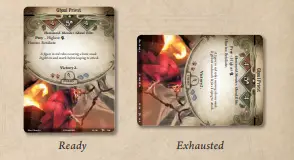
- Locations represent various places players travel to and look for clues
- Location cards have 2 sides:
- UNREVEALED
- REVEALED
- Revealed side shows the clue details
- Location enters play UNREVEALED. When an investigator enters location for 1st time, it is REVEALED
- Number of clues equal to location’s clue value are placed on that location
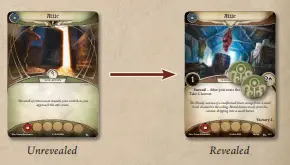
Skills and Skills Test
Investigators have 4 skills
- Willpower
- Intellect
- Combat
- Agility
Skill Test
During the game, investigators may need to perform a Skill Test. This involves the following:
- the player reveals a random chaos token from the chaos bag
- the chaos token modifies the player’s skill value
- investigator passes the Skill Test if modified skill value exceeds test difficulty value
Modifying Skill Value for Skills Test
Before drawing Chaos Token, the investigator may boost their skill value
- Investigator can use eligible cards from hand to help with the skills test
- Eligible card has one or more icons matching the skill type of the test being performed. Wild icon matches all skill types.
- Each matching icon used for the test increases the investigator’s skill value by 1 for that test
- Investigator may commit any number of cards for their hand
- Other Investigators at the same location can assist by committing 1 card from their hand to help
- Do not pay card’s resource cost when using it for the skills test
- The investigator may also activate free trigger abilities to modify their skill for the test
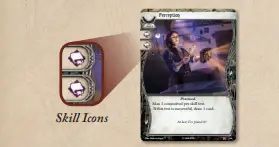
Chaos Token Effects
Each chaos token has a symbol or value that modifies the outcome of the skills test
- Each chaos token has the following effect:
- Refer to scenario reference card and resolve the corresponding effect
- Refer to investigator card and resolve the investigator’s ability
- Automatic failure of the skills test
- If the token has a value, that value modifies the investigator’s skill value for this test
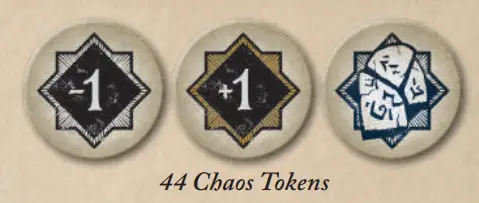
Conclusion of Skills Test
Modified Skill value is higher than difficulty value of Skill, Investigator passes.
Otherwise, it is a failure.
- Ability or game step that initiated the skill will provide instructions for consequences of success and failure
- Some skill cards have abilities that resolve upon completion of skill test
- Upon completion of the skill test, discard all investigator cards used to that test, return chaos token to chaos bag
Weakness Card
- a card that has ill effect when drawn by the investigator
- cards are identified by the labels:
- WEAKNESS
- BASIC WEAKNESS
- when drawn, the investigator who drew card must resolve its “Revelation ” ability immediately
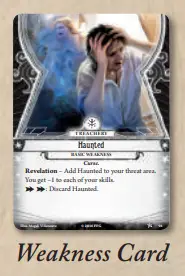
Keywords/ Instructions/Symbols and Icons
Keywords
Aloof: An aloof enemy does not engage investigators of its own accord. (An investigator may use an action or a card ability to engage it.) An investigator cannot attack an aloof enemy unless he or she is engaged with it.
Fast: A player may play a fast card without spending an action.
Hunter: Each hunter enemy moves one location toward the nearest investigator at the beginning of the enemy phase. Massive: A massive enemy is engaged with each investigator at its location.
Peril: When an investigator draws a card with the peril keyword, that investigator cannot confer with or receive assistance from other players while resolving the card’s revelation ability and/or spawning it.
Retaliate: If an investigator fails a skill test while attacking an enemy that has the retaliate keyword, the enemy (if it is ready) performs its attack (damage and horror) against the investigator.
Surge: After an investigator draws and resolves an encounter card that has the surge keyword, that investigator must draw and resolve an additional card.
Uses (X): The uses keyword creates and defines a particular token type to be placed on a card when that card enters play. The value following the keyword indicates a number of resource tokens to be placed on the card to represent the specified token type. These tokens are used in conjunction with the rest of the card’s ability
Instructions
Spawn: Indicates where an enemy spawns when drawn.
Prey: Indicates which investigator an enemy will engage (or move toward if it has the hunter keyword) if there are multiple valid options.
Timing Triggers
Action Trigger: Costs an action to use this ability.
Free Trigger: Does not cost an action to use this ability.
Reaction Trigger: May be used once each time the specified timing point occurs. Does not cost an action.
Symbols and Icons
